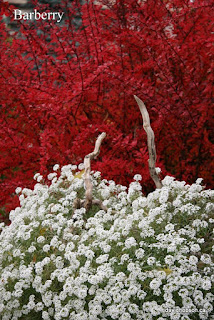 It's that time of year when I feel compelled to join the
Christmas onslaught and suggest a list of possible gifts for gardeners, much as
I've done in the past. You know — buy this book, that tool, or those seeds.
It's that time of year when I feel compelled to join the
Christmas onslaught and suggest a list of possible gifts for gardeners, much as
I've done in the past. You know — buy this book, that tool, or those seeds.
If my intention is truly to support gardeners and ensure
they receive an appropriate, garden related gift, then it might make more sense
to disguise this column and connive to have it printed in the sports or
business section of the paper.
This is not meant to be sexist in any way,
suggesting that all garden gifters are male while garden giftees are female,
nor am I claiming that the fairer sex (and even that statement can be
troublesome) never read the sports or business sections — BUT and it's a big
BUT, I have overwhelming evidence to support my argument that the majority of
gardeners in North America are female rather than male. It's much the same in
Europe, although much less so in Britain.
 I grew up there where it was perfectly acceptable for men to
grow plants and flowers. My dad did, my uncles did, and so did their male neighbours.
I grew up there where it was perfectly acceptable for men to
grow plants and flowers. My dad did, my uncles did, and so did their male neighbours.
The popular pastime of tending a small allotment (a community
garden) was largely the prerogative of men, and they didn't produce only
cabbages and potatoes. They spent just as much time on growing perfect dahlias,
mums, or sweet peas; although I'll willingly admit there was an element of
competitiveness.
A conversation between men about flowers was just as likely to
be overheard in the local pub as one about cricket, rugby or soccer. This makes
it difficult for me. Whenever I sit down with a bunch of guys, say for coffee
or a beer, the conversation frequently turns to cars, baseball, or hockey. It
never seems quite the right time for me to say, "Hey, anyone like to see
pictures of my prize peony?"
 No, the garden world is strongly weighted on the feminine
side. Need more proof? Since 1998, I've operated a website called Garden
Humour. Readers there can take a test to determine if they are a mad,
passionate, gardener. Pass the test (and no one fails), and the applicant
receives a certificate of membership in the fictional International Society of
Mad Gardeners. Thousands have applied and guess what: 95% are women.
No, the garden world is strongly weighted on the feminine
side. Need more proof? Since 1998, I've operated a website called Garden
Humour. Readers there can take a test to determine if they are a mad,
passionate, gardener. Pass the test (and no one fails), and the applicant
receives a certificate of membership in the fictional International Society of
Mad Gardeners. Thousands have applied and guess what: 95% are women.
I also receive quite a few emails and letters in response to
the columns I write. Guess who writes most often? I often speak at garden clubs
and horticultural societies, too, and I can tell you, there is never, ever, a
line-up at the men's washroom.
This isn't a scientific survey, but I've a feeling that the
majority of my readers are more likely women, although any apparent lack of
interest in gardening on the part of men could be due to them traditionally
preferring not to ask for advice, but rather to figure things out for
themselves.
Regardless, the question of what to suggest as Christmas gifts for
gardeners is more easily solved, since it's a given that, children excepted,
those buying these gifts will most likely be men. As this is the case, there's
a strong possibility that a large number of gifts will be hurriedly purchased
at the last minute from a garden gift store on Christmas Eve.
 Many of these
gifts will typically be what I call garden accoutrements. This is not
necessarily a bad thing. Men can have good taste. I mean, you can hardly expect
him to remember the more practical items you hinted at when you dragged him whining
to a garden show last spring.
Many of these
gifts will typically be what I call garden accoutrements. This is not
necessarily a bad thing. Men can have good taste. I mean, you can hardly expect
him to remember the more practical items you hinted at when you dragged him whining
to a garden show last spring.
Because my research on the gender balance of gardeners is
impeccable, I feel I can safely say that gardeners are overwhelmingly practical
types, and more than anything, they will appreciate a gift they can actually use.
Having said that, it is essential that a Christmas gift be a complete surprise,
and so when you make up a list to pin on the fridge or slip into the sports
section, be sure to make it a long one, and yes, it is permissible to underline
certain items.
And what am I putting on my Christmas list? I'm seriously
considering a request for a tee shirt printed with the slogan: REAL MEN GROW
PETUNIAS.














